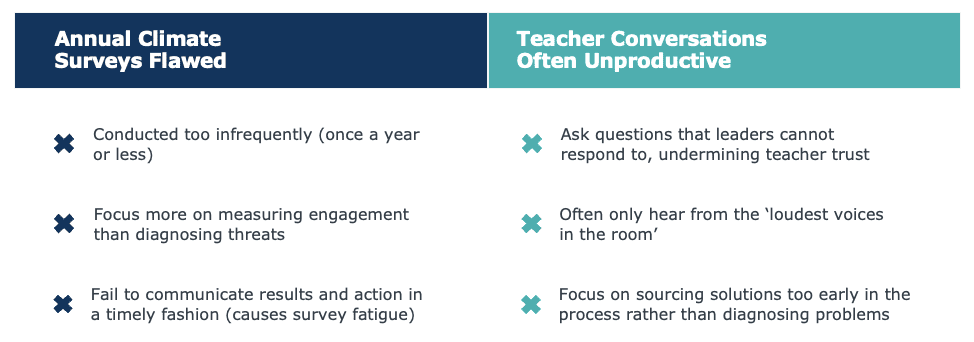Low teacher morale is still a top issue. Here’s why your annual climate surveys aren’t enough.
January 9, 2024, By Chrysanthi Violaris, Senior Analyst, Strategic Research
Low teacher morale is not a new problem for the K-12 system. It predates the pandemic and continues to be a barrier to other district-wide improvement initiatives. Quick-fix alternatives, like hiring more teachers or offering salary increases, are not viable options for most districts. Declining enrollment in teacher education programs, tight public finances, and a highly polarized political climate limit what district leaders can actually do. Additionally, other common teacher appreciation strategies (e.g., thank-you cards and free lunches) – while well-intentioned – fail to get to the root causes of low teacher morale.
Leaders must understand the causes of low morale in their district to make progress. Most current approaches to diagnosing causes of low morale don’t work. Read below to understand why and what to do instead.
Why Current Approaches Don’t Work
The most common approach we see districts using to diagnose teacher morale issues is climate surveys. They give teachers the opportunity to air their grievances and district leaders gather intelligence needed to address low morale. Yet, climate surveys are typically only offered annually and measure engagement (e.g., asking teachers if they have job satisfaction) instead of identifying threats to morale. Our research found that most districts fail to gather the right information over the right timeframe to make any actionable insights.
Leaders typically use focus groups and town halls to gather qualitative data on the causes of low morale. Unfortunately, these discussions tend to be dominated by the loudest voice in the room and raise questions that leaders cannot answer in public. Rather than creating an opportunity to fully understand teachers’ current problems, these meetings can sow distrust in leadership and produce intangible ideas instead of actionable solutions.
Current Approaches to Diagnosis Miss the Mark

Get Teacher Surveys Right
To collect the insights you need to understand low teacher morale, district leaders must create surveys that require minimal time and effort to complete, show a distinction between school settings (e.g., different surveys for elementary and middle schools), and fit within everyone’s busy workload.
Whether new surveys replace or supplement existing annual climate and engagement surveys, you should evaluate teacher morale multiple times a year. Research shows that conducting quarterly pulse assessments of employee engagement directly contributes to a 19 percent improvement in that same metric. Additionally, frequent surveys provide insight into potential flight risks in your district; individuals who choose not to participate in two or more surveys are more than twice as likely to leave within the next year.
Surveys need to also include questions that identify the reasons for low morale rather than measure general engagement. To do so, ask diagnostic questions on a Likert scale related to common stress topics for teachers, like time and resources. For example, asking teachers to rate their agreement to the statement “I have the materials and resources needed to teach well” points to a problem causing low morale as opposed to measuring morale.
Once you have a sense of what the largest underlying causes of low morale are in your district, you can begin the work of starting to address them.
Interested in learning more about how EAB can help improve morale in your district? Visit our Teacher Morale Collaborative page for more information.

More Blogs

Building systems for principal success: 3 key lessons for district leadership

How to get further, faster: the eight hallmarks of successful strategic initiatives
